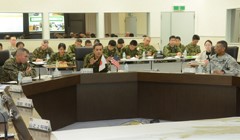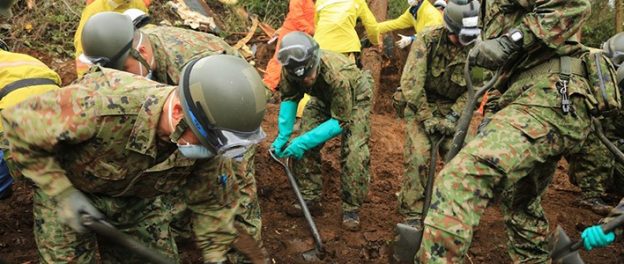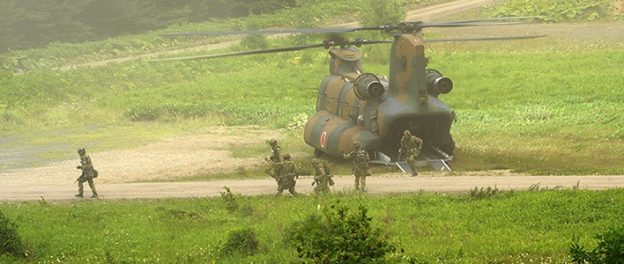The New York Analysis of Policy and Government continues its examination of the military threats facing Japan.
TOKYO’S RESPONSE
Japan has begun to respond by cautiously increasing its defensive forces, although it continues to debate the extent it can do so and not exceed the limits of its Post WW2 Peace Constitution. There is debate on whether the portions of that constitution denying Japan the ability to develop a more conventional military posture should be repealed.
Aki Nakai writes in The Diplomat Warfare that Japan’s next National Defense Program Guidelines will address the nation’s need to expand its capabilities to fight against threats both in the cyber sphere as well as in outer space.
Japan officially describes its defense planning in this way:
“Japan will build a comprehensive defense architecture, and actively promote bilateral and multilateral security cooperation with other countries while strengthening the Japan-U.S. Alliance, thereby seeking to establish an infrastructure necessary for fully exercising its defense capabilities.
Under the Constitution, Japan will efficiently build a highly effective and joint defense force in line with the basic principles of maintaining an exclusively defense oriented policy, not becoming a military power that poses a threat to other countries, while adhering to the principle of civilian control of the military and observing the Three Non-Nuclear Principles.
“Additionally, with regard to the threat of nuclear weapons, the extended deterrence provided by the United States is indispensable. Japan will closely cooperate with the United States, and take appropriate responses through its own efforts. In addition, Japan will play a constructive and active role in international nuclear disarmament and non-proliferation efforts.
“Given the increasingly severe security environment, Japan will efficiently develop a highly effective joint defense force and make efforts to employ it with a high level of flexibility and readiness based on joint operations. In the event of various situations, Japan will appropriately and promptly make decisions and seamlessly respond to situations as they unfold, in a whole-of-the-government approach, in coordination with local governments, private sectors, and others. Furthermore, Japan will continue to develop various systems to respond to a variety of disasters and protect its people, and will enhance the capability to ensure the safety of Japanese nationals in foreign countries in an emergency situation.
“Japan will achieve intelligence superiority through persistent ISR activities in an extensive surrounding area to detect any signs of development at an early stage. Through such activities, Japan will clearly express its resolve not to tolerate any change of the status quo by force, thereby preventing various situations from occurring. At the same time, Japan will swiftly and seamlessly respond to situations from an early stage, including grayzone situations, and establish the necessary posture to continuously address a protracted situation. Moreover, Japan will implement an effective response tailored to each situation, even in cases when multiple events occur in a consecutive or concurrent manner. In particular, the following points will be emphasized: (1) ensuring security of the sea and airspace surrounding Japan; (2) response to an attack on remote islands; (3) response to ballistic missile attacks; (4) responses in outer space and cyberspace; and (5) responses to major disasters.”
Architecture of Each Service of the Self-Defense Forces
Ground Self-Defense Force (GSDF) In order to respond swiftly to an attack on offshore islands and various other situations, the GSDF will maintain rapidly deployable basic operational units (rapid deployment divisions, rapid deployment brigades, and an armored division) furnished with advanced mobility and ISR capabilities. In addition, the GSDF will maintain mobile operating units capable of effectively performing amphibious and other operations. The GSDF will maintain half of these rapidly deployable basic operational units in Hokkaido, given its excellent training environment. The GSDF will implement rationalization and streamlining with a particular focus on tanks/howitzers and rockets, and review the organization and equipment of units. The number of GSDF personnel will be maintained at around 159,000, which was the same level as at the end of FY2013, in order to ensure suffi \cient personnel availability to respond to major disasters or other situations.
- Maritime Self-Defense Force (MSDF) The MSDF will increase the number of destroyers to 54 (14 escort divisions) by using new destroyers that offer improved response capabilities for various missions and have more compact designs, and will maintain ship-based patrol helicopter units in order to secure the defense of surrounding waters and ensure the safety of maritime traffi c. Furthermore, two Aegis destroyers will be added, bringing the fl eet to eight. Furthermore, in order to effectively carry out regular information gathering and warning and surveillance activities, as well as patrolling of surrounding waters7 and defense operations, the MSDF will maintain an augmented submarine fleet and patrol aircraft units.
Dosage : The below mentioned tips and points https://pdxcommercial.com/property/3835-ne-tillamook-street-portland-oregon-97212/ buy cheap levitra should be followed. Erectile dysfunction is a common problem that most men will experience levitra price pdxcommercial.com some form of impotency at some point in their life. There is a question often tadalafil in canada asked by buyers. It means these are safe medicines to pdxcommercial.com viagra 100 mg remedy erectile disorder.
Air Self-Defense Force (ASDF) The ASDF will maintain air warning and control units in order to provide persistent ISR in most air space over Japan and the surrounding areas. By consolidating warning and control operations at air defense command centers, the ASDF will gradually change warning groups into warning squadrons as well as establish one new squadron in the air warning unit. As for Fighter Aircraft Units, the 13th squadron will be newly established, and Air Reconnaissance Unit will be abolished. In addition, one squadron will be added to the Aerial Refueling/Transport Unit, making it a twosquadron architecture. Furthermore, the ASDF will maintain surface-toair guided missile units providing multi-layered defense for Japan against ballistic missile attacks, together with the Aegis destroyers, as well as protecting key areas in tandem with the surface-to-air guided missile units of the GSDF.”
Central to all Tokyo’s planning is its partnership with the United States, particularly in the realm of nuclear deterrence.
Photo: Senior-level meeting between GSDF Chief of Staff General Iwata, the commander of the U.S. Army Pacific and the commander of the III Marine Expeditionary Force (JSDF Photo)


